 The role played by evergreens in the landscape could hardly be overstated in northern climates. The deciduous plant material in my landscape will finish their annual shedding come the end of October or the beginning of November. It will be another 6 months before I lay eyes on an emerging leaf. That is a long time to do without any green. Many evergreens have needles in lieu of leaves. A green needle presents a very small surface area to the extreme cold and desiccating winds that are common in our winters. Water evaporates from a needle at a much smaller rate than it does from a leaf. That size restraint nature bestowed on the chlorophyll producing needles of evergreens means they are able to survive the winter in spite of the fact that their roots are frozen, and unable to take up water or nutrients. An evergreen hardy in my zone is engineered to endure. This is not to say that evergreen needles cannot burned by extreme cold and wind-they can. But in a reasonable winter, the green will endure. Leaves, whether they be from perennials, shrubs or trees, are not engineered to survive our winters. Thus the mechanism that we know as fall causes plants to shed their leaves ahead of the deep freeze. Though an evergreen is dormant in the winter, they are able to sustain their green. That green is much darker, more somber and entirely fitting for a winter season. In looking at the above picture, I notice two things. My eye does not focus on the winter branches of the neighborhood maples. What I see first is the green. Secondly, I realize I may have devoted too much space to an evergreen presence in my landscape. I have my reasons.
The role played by evergreens in the landscape could hardly be overstated in northern climates. The deciduous plant material in my landscape will finish their annual shedding come the end of October or the beginning of November. It will be another 6 months before I lay eyes on an emerging leaf. That is a long time to do without any green. Many evergreens have needles in lieu of leaves. A green needle presents a very small surface area to the extreme cold and desiccating winds that are common in our winters. Water evaporates from a needle at a much smaller rate than it does from a leaf. That size restraint nature bestowed on the chlorophyll producing needles of evergreens means they are able to survive the winter in spite of the fact that their roots are frozen, and unable to take up water or nutrients. An evergreen hardy in my zone is engineered to endure. This is not to say that evergreen needles cannot burned by extreme cold and wind-they can. But in a reasonable winter, the green will endure. Leaves, whether they be from perennials, shrubs or trees, are not engineered to survive our winters. Thus the mechanism that we know as fall causes plants to shed their leaves ahead of the deep freeze. Though an evergreen is dormant in the winter, they are able to sustain their green. That green is much darker, more somber and entirely fitting for a winter season. In looking at the above picture, I notice two things. My eye does not focus on the winter branches of the neighborhood maples. What I see first is the green. Secondly, I realize I may have devoted too much space to an evergreen presence in my landscape. I have my reasons.
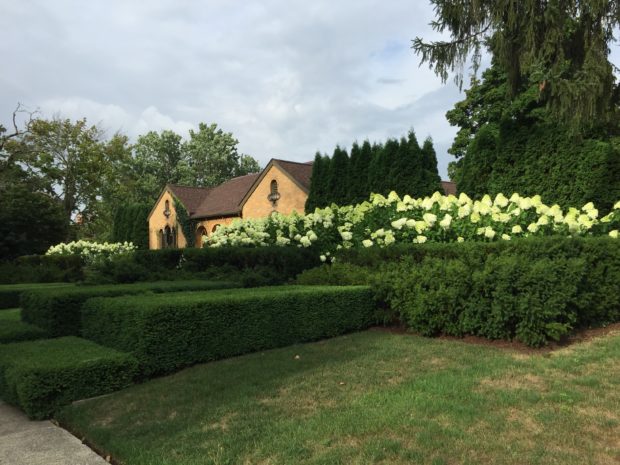 The time I have available to tend to my landscape is limited. I like to come home to a good look, not a a lot of work to be done on top of the workday I have already worked. This need for an orderly and low maintenance landscape is particular to me. What any gardener needs from a landscape and garden is particular to them, and the zone where they garden. My evergreens represent beautifully to my eye no matter the season, and no matter the weather. A landscape featuring trees and shrubs is a landscape that looks well kept, and can be kept well kept with a minimum amount of work, all year round. This picture taken in late summer illustrates how evergreens can provide structure to a landscape. Structure? The composition and form of my landscape is established by the evergreens. My Limelight hydrangeas break bud in April, and by the beginning of August their flowers are the star of the show. But the evergreens provide a foreground element, and a background element that enhances that look. The Hicks and densiformis yews disguise the woody green leaved legs of those hydrangeas. The arborvitae behind them provide a dark green backdrop that makes those greenish white blooms all the more striking.
The time I have available to tend to my landscape is limited. I like to come home to a good look, not a a lot of work to be done on top of the workday I have already worked. This need for an orderly and low maintenance landscape is particular to me. What any gardener needs from a landscape and garden is particular to them, and the zone where they garden. My evergreens represent beautifully to my eye no matter the season, and no matter the weather. A landscape featuring trees and shrubs is a landscape that looks well kept, and can be kept well kept with a minimum amount of work, all year round. This picture taken in late summer illustrates how evergreens can provide structure to a landscape. Structure? The composition and form of my landscape is established by the evergreens. My Limelight hydrangeas break bud in April, and by the beginning of August their flowers are the star of the show. But the evergreens provide a foreground element, and a background element that enhances that look. The Hicks and densiformis yews disguise the woody green leaved legs of those hydrangeas. The arborvitae behind them provide a dark green backdrop that makes those greenish white blooms all the more striking.
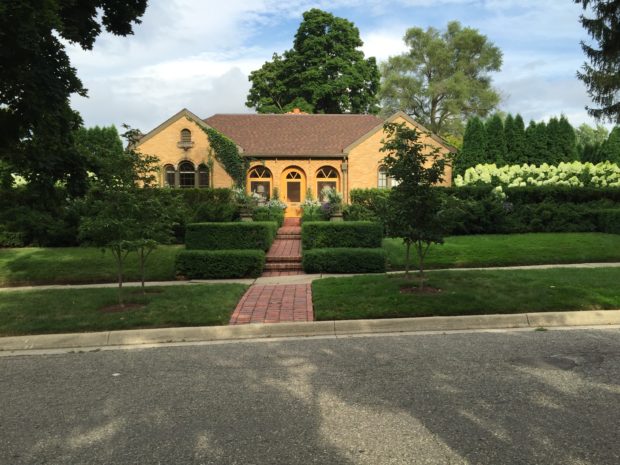 I am appreciative of all the evergreens have to offer in season. They are obligingly green as can be. Evergreens are densely foliated and lush. They do an excellent job of screening an untoward view, or creating shapes of all kinds planted en mass. This spring I did no pruning whatsoever to them. The boxwood were pruned in late June of 2015, after the spring flush of grown. The spring growth in 2016 was relatively uniform, so I skipped pruning them. A year off the shears never hurt a plant or a gardener. The arborvitae should be pruned. A severe ice storm could prove damaging. Keeping them at a shorter and uniform height takes advantage of the strength inherent in a group. Some individual trees that seem wobbly are already kept in line by strapping their trunks in several places to the trunks of their neighbors with arborist’s tree tie webbing.
I am appreciative of all the evergreens have to offer in season. They are obligingly green as can be. Evergreens are densely foliated and lush. They do an excellent job of screening an untoward view, or creating shapes of all kinds planted en mass. This spring I did no pruning whatsoever to them. The boxwood were pruned in late June of 2015, after the spring flush of grown. The spring growth in 2016 was relatively uniform, so I skipped pruning them. A year off the shears never hurt a plant or a gardener. The arborvitae should be pruned. A severe ice storm could prove damaging. Keeping them at a shorter and uniform height takes advantage of the strength inherent in a group. Some individual trees that seem wobbly are already kept in line by strapping their trunks in several places to the trunks of their neighbors with arborist’s tree tie webbing.
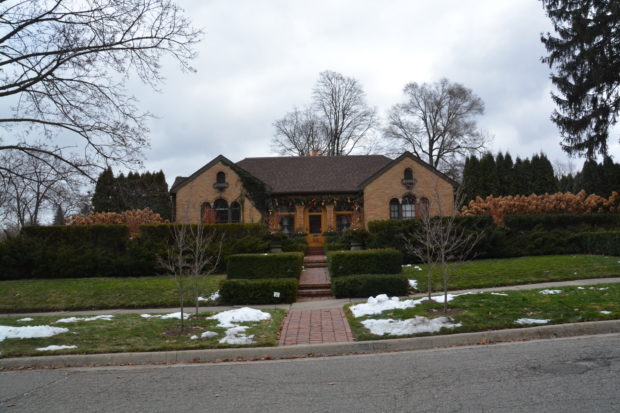 But the time of year that I am most happy for my evergreens is the winter. That green in the off season is a pleasure and a comfort. They provide a visual sense of warmth and enclosure during a very cold and inhospitable time of year. The mature flower heads of the mass of the deciduous hydrangeas do add color and volume to the winter garden, no doubt. The evergreens not only provide green in the off season, they screen the view of the bare branches of the hydrangeas from the street view.
But the time of year that I am most happy for my evergreens is the winter. That green in the off season is a pleasure and a comfort. They provide a visual sense of warmth and enclosure during a very cold and inhospitable time of year. The mature flower heads of the mass of the deciduous hydrangeas do add color and volume to the winter garden, no doubt. The evergreens not only provide green in the off season, they screen the view of the bare branches of the hydrangeas from the street view.
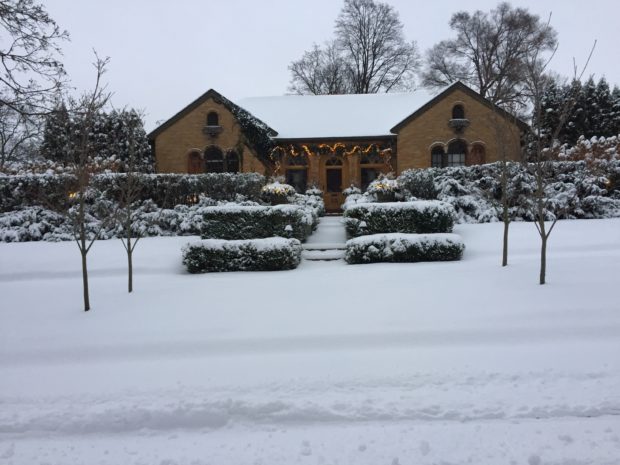 The snow we had last week was friendly to my landscape, in that the design and form established by the evergreens is still evident. Snow falling on an established structure of a variety of evergreens can be beautiful.
The snow we had last week was friendly to my landscape, in that the design and form established by the evergreens is still evident. Snow falling on an established structure of a variety of evergreens can be beautiful.
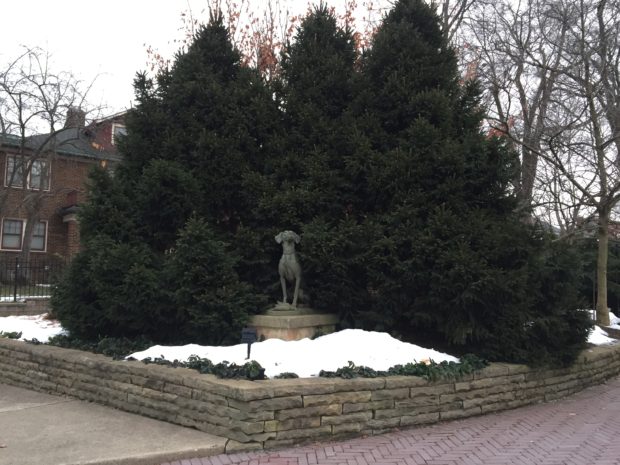 Four picea abies mucronata were in the front of the house when I bought it 20 years ago. They were about 4 feet tall when I transplanted them to the driveway side. That was the last time I did anything to them, except look at them. I do not need to weed, nor do I feed them. I do water the hellebores in front of them when they need it. The needles go quite black green in winter.
Four picea abies mucronata were in the front of the house when I bought it 20 years ago. They were about 4 feet tall when I transplanted them to the driveway side. That was the last time I did anything to them, except look at them. I do not need to weed, nor do I feed them. I do water the hellebores in front of them when they need it. The needles go quite black green in winter.
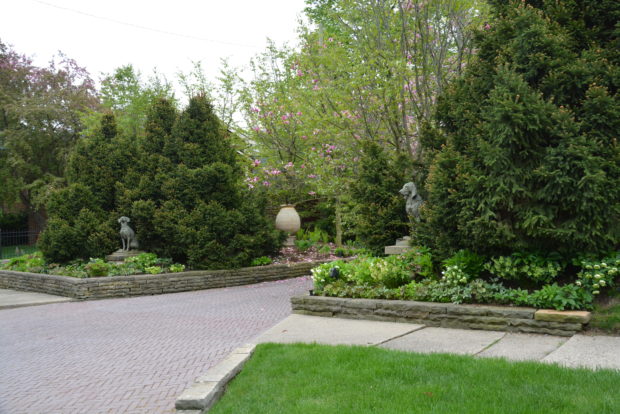 In the spring, the new growth is chartreuse. My hellebores stay green most of the winter, although 4 ” of snow will completely cover them.
In the spring, the new growth is chartreuse. My hellebores stay green most of the winter, although 4 ” of snow will completely cover them.
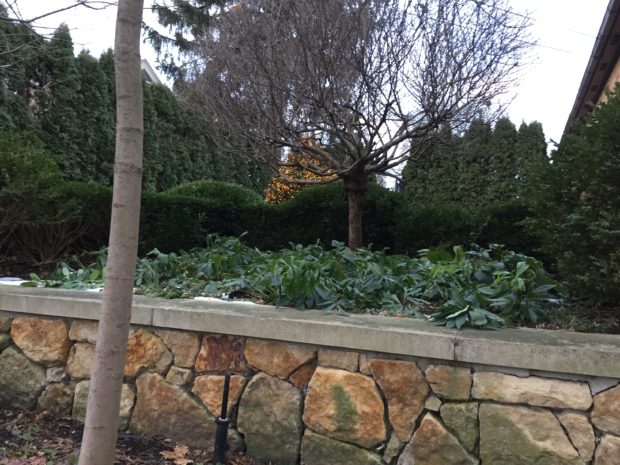 We rarely have snow cover that comes in early January and persists until March. We have no snow on the ground now. This is the third winter for this new batch of hellebores. As they were 4″ pots when I planted them, I think it is safe to say they are happy here. I am happy to have this evergreen groundcover patch to look at.
We rarely have snow cover that comes in early January and persists until March. We have no snow on the ground now. This is the third winter for this new batch of hellebores. As they were 4″ pots when I planted them, I think it is safe to say they are happy here. I am happy to have this evergreen groundcover patch to look at.
 This spreading yew was big when I bought the house. I would guess it has been there over 30 years. It is a great example of how evergreens can be used in an informal setting to great effect. Buck occasionally complains that it has encroached on the driveway, but I rather like how it has softened the look of the stone and concrete brick drive. The bare patch of snow and dirt to the left? It is ferns and hostas in the summer. That spot will be bare until May.
This spreading yew was big when I bought the house. I would guess it has been there over 30 years. It is a great example of how evergreens can be used in an informal setting to great effect. Buck occasionally complains that it has encroached on the driveway, but I rather like how it has softened the look of the stone and concrete brick drive. The bare patch of snow and dirt to the left? It is ferns and hostas in the summer. That spot will be bare until May.
 Boxwood are broad leaved evergreens. They can be more susceptible to winter burn than needled evergreens, as those leaves have a big surface area through which water inside the leaf is constantly transpiring, or evaporating to the atmosphere. The most effective way I know to limit damage from winter burn is to spray them with a commercial grade antidessicant. I use Vapor Gard. This water based wax is made from pine resin. The wax coats the leaves, and helps prevent moisture loss. I find it to be much more effective and much less unsightly than burlap. That said, in our truly terrible winter 3 years ago, I did have patches where the boxwood died back, leaves and stems. The plants have begun to grow out of this. I do nothing to protect my boxwood, as they are all growing in fairly sheltered places. In January, they have a much stronger visual presence than my deciduous trees.
Boxwood are broad leaved evergreens. They can be more susceptible to winter burn than needled evergreens, as those leaves have a big surface area through which water inside the leaf is constantly transpiring, or evaporating to the atmosphere. The most effective way I know to limit damage from winter burn is to spray them with a commercial grade antidessicant. I use Vapor Gard. This water based wax is made from pine resin. The wax coats the leaves, and helps prevent moisture loss. I find it to be much more effective and much less unsightly than burlap. That said, in our truly terrible winter 3 years ago, I did have patches where the boxwood died back, leaves and stems. The plants have begun to grow out of this. I do nothing to protect my boxwood, as they are all growing in fairly sheltered places. In January, they have a much stronger visual presence than my deciduous trees.
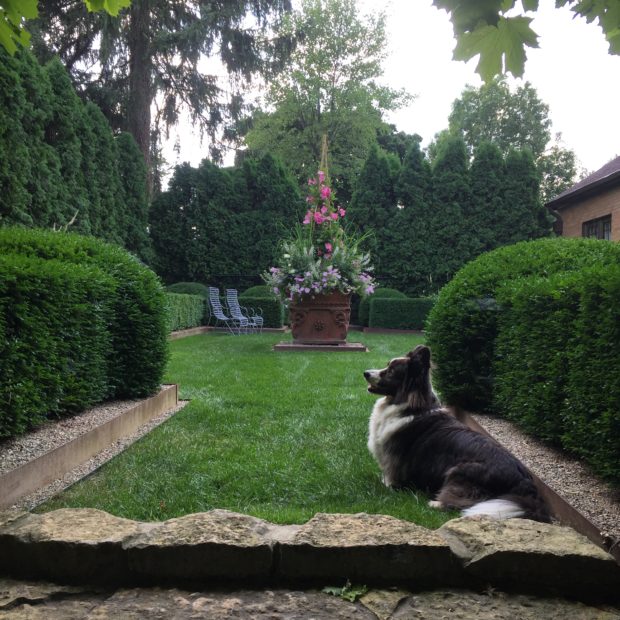 No doubt the green of the boxwood in summer is vibrant. Live green, I call it.
No doubt the green of the boxwood in summer is vibrant. Live green, I call it.
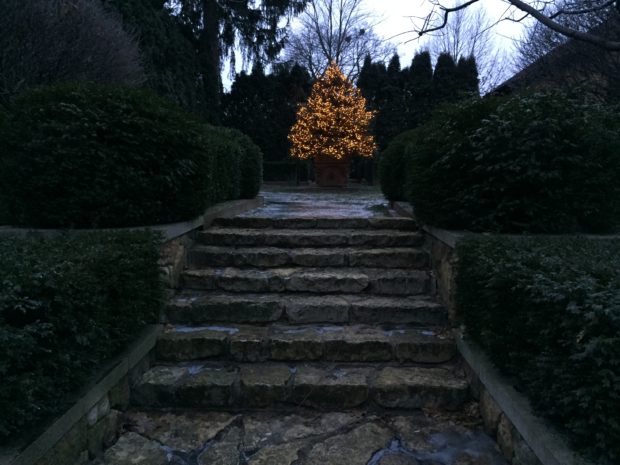 The dormant green is not as showy, but it is green nonetheless. The texture and shape stay the same throughout the seasons. What the weather of each season does to the evergreens is my greatest source of pleasure in my own landscape.
The dormant green is not as showy, but it is green nonetheless. The texture and shape stay the same throughout the seasons. What the weather of each season does to the evergreens is my greatest source of pleasure in my own landscape.
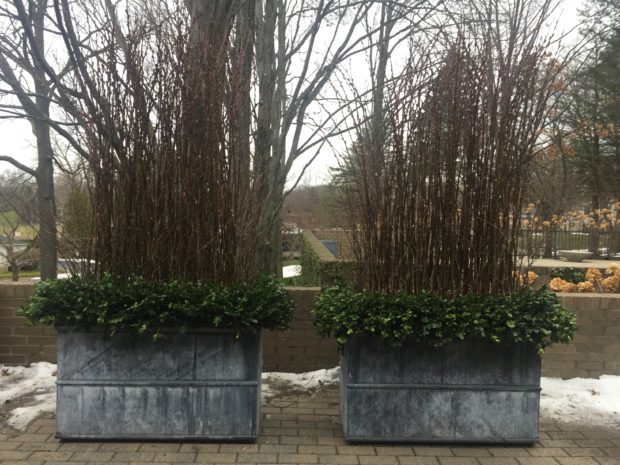 This is surely why most all of our winter containers feature cut evergreens. Even the trimmings will stay green all winter. Amazing, that.
This is surely why most all of our winter containers feature cut evergreens. Even the trimmings will stay green all winter. Amazing, that.
Your dog looks like he/she is really enjoying the garden. Lovely!
Dear Lynn, Milo would be outside day and night if he had his choice.The winter is a subtle version of jail.Not that he can’t stay out in the cold and snow for a long time. I just hate to go with him! He is one unhappy dog! all the best, Deborah
Nice Article In our ‘more southern clime’ we seldom have to deal with too many months of no leaves. Your perspective is spot on. Almost always agree with your perspectives
BTW – used to use ‘Wilt Pruf” – semi-acceptable results. Like VaporGard better
Thanx a million, Richard
Dear Richard, VaporGard is a very serious version of wilt pruf. Any evergreens that I plant for a client after September 1, I make the guarantee conditional on an application of VaporGard. Always happy to hear from you. best regards, Deborah
Your landscaping is picture perfect! Beautiful in all four season’s. You always give wise advise and food for thought for our own landscaping. Thank you!
Dear Jeannine, if you had a chance to inspect up close, you would see things that are not so perfect! I have an aging landscape that has issues.The best part is that it all keeps me busy! best, Deborah
I’m with you Deborah. I have to have green in my landscaping for Winter. I live in Central North Carolina and our winter temperature this year has been from 20’s to 70’s in a matter of 4 days. We have already had ice & snow. It will be interesting to see what survives. Some of my Boxwoods planted in iron urns have turned brown. This is the first time they have been affected in Winter. Thanks for all the information. Your landscaping is Classic Beauty!
Deborah,
Beautiful and elegant as always! Your gardens have the look of private gardens in Italy or France. Love the photo of Milo and the large pretty pot in the center distance with the pink mandevilla teepee trellis. It’s inspiring to many of us to get going on some well-kept evergreen hedges!
Lovely landscape. Your placement of evergreens is to perfection. Many years ago I planted
Norway Spruce, in triangulation, on a berm to block a view of my neighbor’s back yard. Today the trees are 25 feet tall and they provide a great enclosure for me. They also provide a nice backdrop for my croquet lawn.
I will purchase some VaporGard. I have not lost any evergreens but I plan on adding to my landscape and will use this as protection. Thank you for sharing.. Susan .
The large terracotta pot surrounded by the evergreen setting is incredibly perfect!
Enjoyed your article. In it you mentioned Hellebores. Where is the best place to plant them?
Enjoyed your photos. You take great care educating your readers.
Many Thanks.
Very interesting article and pictures.! This past year I was given a Hellebore plant and do see now when the snow has melted it is mostly green———- sets alone in a wild setting. What do I need to do to maintain it? Does one leave the same leaves year round? Any other special care? Thanks for all y0our articles and help. Carol
Dear Carol and Lenore, if you google “growing hellebores” you will find lots of articles. You can also add your zone or area to your search. Good luck! all the best, Deborah
The gardens I like best are mostly green. You have a beautiful, peaceful garden, Deborah, a refuge; reminds me of Italy. I always enjoy your pictures, especially the photo of the urn centered between the two dog statues flanking the drive. Best wishes to you and Buck in 2017.
Thanks for the inspiration Deborah. This past November we completed an new install of Rosetta Stone patio with pillars and small wall in our typical smallish suburban Northville backyard and side walkway. The majority of the yard in back is more loose, perennial and shrub mixed garden which we installed ourselves. My goal is to use more structure and green around the patio to provide privacy, relief to the eye from the colorful backyard garden, and easy maintenance. This article reminds me of the importance of winter interest, which will be critical since so much of the patio is easily seen from the yard. Thank you!
Enjoyed your article again. Do you have hellebores available now for purchase?
Dear Lenore, we have a hellebore festival in early March.I am sure I will write about it in a advance of the date. best regards, Deborah
I had no idea Hellebores were evergreen. What a wonderful surprise. Thanks. Melanie
Dear Melanie, the helleborus hybridus cultivars are evergreen in my zone, unless we have a more bitterly cold winter than usual. In a terrible winter, the leaves will go brown, and lay flat against the ground. Test this evergreen habit in your own garden by planting a few plants. The local experience is always the best. regards, Deborah
Dear Deborah,
Writing from Paris -France. I’m in the midst of starting a project at my house in Provence (30 acres) where an English lady “helping me” ordered 604 taxus bacchata for an in-closed garden of 6 acres.
Not very “Dirt Simple” so to speak and quite funereal. I’ve tried hornbeams elsewhere in our place and, against all expectations, they did really well, with minimum attention. And local, hornbeam, it is not (with heat and plant’s worse ennemy: wind, in our case Le Mistral, furiously blowing from the Rhône valley and dessicating every piece of land in its way).
Your blog is good as it inspires gardeners to engage in trials and errors (safe miscalculations on the pH of the ground which are very hard to correct).
I did my garden in Bellport, Long Island, years ago. No one there had ever tried hornbeams. I did and added roses on the house front porch pillars, climbing 15 feet high, roses that my friends there had never tried (American Pillar, New Dawn, Alberic Barbier etc;). The little trick that made them grow so well, was to take my wheelbarrow down to the bay in the winter, fill it with algae, spread them on the gravel, wait for enough rain to take the salt away, and spread them around the climbing roses.
They loved it.
Trials and errors. Somehow, allways works with passionate gardeners. And plants do love attention. Look at last week-end’s edition of the Financial Times. Much regarded garden columnist Robin Lane Fox’s article is all about hellébores.
Xx C.